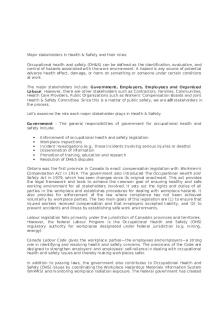Instructions for obtaining health and safety information from Chem Watch PDF

| Title | Instructions for obtaining health and safety information from Chem Watch |
|---|---|
| Author | 衣宸 徐 |
| Course | Chemistry 1 |
| Institution | University of Queensland |
| Pages | 1 |
| File Size | 109.5 KB |
| File Type | |
| Total Downloads | 50 |
| Total Views | 133 |
Summary
Ready for Laboratory activities. Utilise for the pre-lab quiz....
Description
Instructions for obtaining health and safety information from ChemWatch ChemWatch is an Australian-produced chemical safety database used by industries and universities around the world to access Material Safety Data Sheets (MSDS) and other important health and safety resources pertaining to commercially-available chemicals. Australian Law requires that these data sheets be accessible whenever chemicals are handled in an occupational setting. At the University of Queensland, the ChemWatch database provides this information and keeps it upto-date. In the First Level Chemistry Laboratory, you are required to access ChemWatch before all practical classes and obtain some basic information about some of the reagents you will be using. In second and third level courses you will be required to use the database to access more complex information and it is certainly a resource you will use in any laboratory based job. 1. To access the database, go to the UQ Occupational Health website www.uq.edu.au/ohs/, click on the ChemWatch MSDS button and then on 'Log on to ChemWatch’.
2. Log into the database with your UQ student ID and password.
3. Click the GoldMSDS button on the '(M)SDS and LABELS' section of the front page so that the tab is shaded blue.
1. In the Search Panel, type the name of the chemical into the name area. You don’t need to click on the ‘Search’ button, a number of options should be listed. The list of search results may include different formulations (e.g. solutions with different concentrations) as well as derivatives and related compounds. Choose the appropriate option listed and open the MSDS by double clicking the name.
4. Read the MSDS to find the information required from the Pre-lab question or the hazard ratings for your lab manual within the MSDS that opens up....
Similar Free PDFs

Skagen Watch Instructions English
- 16 Pages

Health and Safety Training
- 8 Pages

health and safety essay
- 4 Pages

Health, Hygiene and Safety
- 28 Pages

Health & Safety Assignment
- 9 Pages
Popular Institutions
- Tinajero National High School - Annex
- Politeknik Caltex Riau
- Yokohama City University
- SGT University
- University of Al-Qadisiyah
- Divine Word College of Vigan
- Techniek College Rotterdam
- Universidade de Santiago
- Universiti Teknologi MARA Cawangan Johor Kampus Pasir Gudang
- Poltekkes Kemenkes Yogyakarta
- Baguio City National High School
- Colegio san marcos
- preparatoria uno
- Centro de Bachillerato Tecnológico Industrial y de Servicios No. 107
- Dalian Maritime University
- Quang Trung Secondary School
- Colegio Tecnológico en Informática
- Corporación Regional de Educación Superior
- Grupo CEDVA
- Dar Al Uloom University
- Centro de Estudios Preuniversitarios de la Universidad Nacional de Ingeniería
- 上智大学
- Aakash International School, Nuna Majara
- San Felipe Neri Catholic School
- Kang Chiao International School - New Taipei City
- Misamis Occidental National High School
- Institución Educativa Escuela Normal Juan Ladrilleros
- Kolehiyo ng Pantukan
- Batanes State College
- Instituto Continental
- Sekolah Menengah Kejuruan Kesehatan Kaltara (Tarakan)
- Colegio de La Inmaculada Concepcion - Cebu










